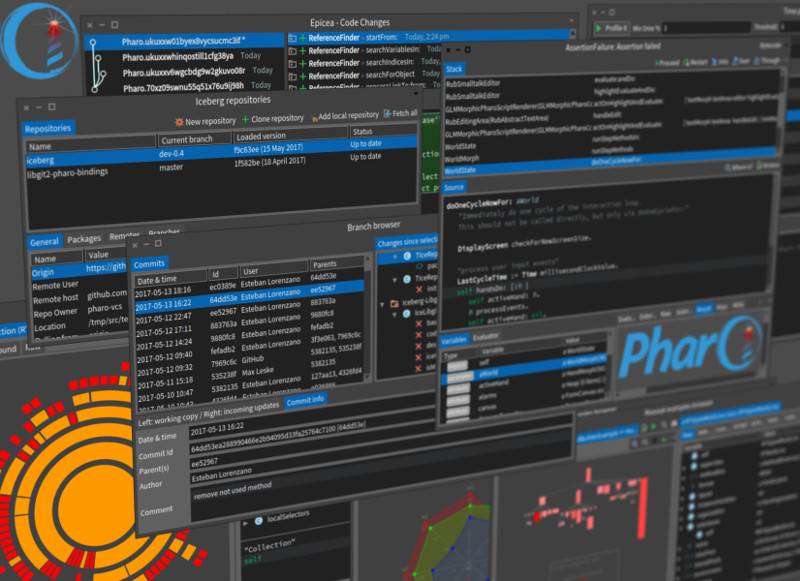Pharo 6.0
Dear World,
The time has come for Pharo 6.0!
Pharo is a pure object-oriented programming language and a powerful environment, focused on simplicity and immediate feedback.
This is our most significant release yet. Here are some highlights:
- Pharo is now provided in 64-bit version in Linux and OSX and brings even better performance and stability (beware, 64bits version is a new technology and a small amount of tests is still failing)
- A new code changes management system named Epicea for easier reviewing and recovering of your code easily
- Integrated support for Git through an easy-to-use tool for repositories and commits management named Iceberg (as a preview for Pharo 6, it will be the default in Pharo 7)
- The unified foreign function interface (UnifiedFFI) for interfacing with the outside world is significantly improved
- The PharoVM is now part of OpenSmalltalk initiative
- Introduction of object immutability, alternative bytecode sets and block closures independent of outer context
- Pharo can now be bootstrapped from source code managed by Git
- Pharo modularity is improved
- Pharo is faster
- The Dark Theme was improved and set as default color theme of Pharo

These are just the more prominent highlights, but the details are just as important. We have closed 1474 issues in Pharo 6.0 (a more complete changelog can be found in the main GitHub repository).
While the technical improvements are significant (starting the transition to 64bits is a remarkable achievement), still the most impressive fact is that the new code that got in the main Pharo 6.0 image was contributed by more than 80 people.
Pharo is more than code. It is an exciting project involving energetic people. We thank all the contributors of this release:
Alberto Bacchelli, Alejandro Infante, Alexandre Bergel, Aliaksei Syrel, Alistair Grant, Andrei Chis, Ben Coman, Bernardo Contreras, Bernhard Pieber, Boris Spasojevic, Christophe Demarey, Clement Bera, Cyril Ferlicot, Dale Henrichs, Damien Cassou, Damien Pollet, Dave Lewis, Denis Kudriashov, Dirk Roeleveld, Eliot Miranda, Esteban Lorenzano, Esteban Maringolo, Evan Donahue, Federico Balaguer, Franck Warlouzet, Glenn Cavarle, Guillermo Polito, Gustavo Santos, Henrik Johansen, Henrik Nergaard, Hilaire Fernandes, Holger Hans, Jan Kurs, Jan van de Sandt, Johan Fabry, Juraj Kubelka, K. K. Subramaniam, Ken Causey, Kris Gybels, Lionel Akue, Luc Fabresse, Lucas Godoy, Marcus Denker, Mariano Martinez Peck, Marion Noirbent, Martin Dias, Max Leske, Maxime Roelandt, Merwan Ouddane, Matteo Bellotto, Miguel Campusano, Milton Mamani, Myroslava Romaniuk, Nicolai Hess, Nicolas Cellier, Nicolas Passerini, Norbert Hartl, Offray Luna, Pablo Tesone, Paul De Bruicker, Pavel Krivanek, Peter Uhnak, Philippe Back, Roger Stebler, Ronie Salgado, Sean DeNigris, Serge Stinckwich, Skip Lentz, Sophie Kaleba, Stefan Reichhart, Stephan Eggermont, Stephane Ducasse, Sven Van Caekenberghe, Thibault Arloing, Thibault Arloing, Thibault Raffaillac, Thierry Goubier, Thomas Heniart, Tommaso Dal Sasso, Torsten Bergmann, Tudor Girba, Udo Schneider, Valentin Ryckewaert, Vincent Blondeau, Werner Kassens, Yuriy Tymchuk
(If you contributed with Pharo 6.0 development in any way and we missed your name, please send us a mail and we will add you).
Enjoy!
The Pharo Team
Try Pharo: http://pharo.org/download
Learn Pharo: http://pharo.org/documentation
